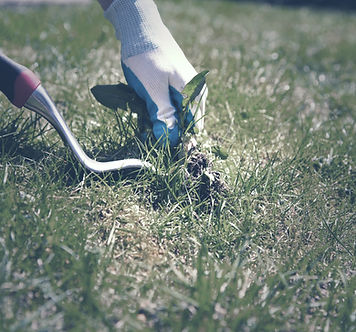

THE YARDLINE BLOG
Troublesome Weeds: A Comprehensive Guide
Weeds can be the bane of any well-manicured lawn. They compete with your grass for nutrients, water, and sunlight, often leading to a patchy, less vibrant lawn. If you're tired of battling these persistent invaders, you're not alone. Here’s a comprehensive guide to help you reclaim your lawn from weeds and keep it lush and healthy.
1. Identify the Weeds
Before you can effectively tackle your weed problem, it's essential to identify the types of weeds you’re dealing with. There are two main categories:
-
Broadleaf Weeds: These include dandelions, clover, and chickweed. They have wide, flat leaves and are often easier to spot.
-
Grassy Weeds: These resemble grass and include crabgrass and quackgrass. They can be more challenging to differentiate from your lawn grass.
Understanding the specific weeds in your lawn will help you choose the most effective control methods.

2. Prevent Weeds from Growing
Prevention is always better than cure. Here’s how you can stop weeds from taking over. Maintaining a healthy lawn is by far the best way to manage weed control. A strong root system will produce a thick and healthy lawn that in turn will be able to outcompete weeds attempting to germinate.
Maintain a Healthy Lawn
-
Mow Regularly: Keep your grass at the recommended height for your grass type. Always maintaining your lawn at a height of more than 2.5”-3” will give your soil the shade it will need to prevent crabgrass seeds or any weeds from germinating.
-
Fertilize: Use a balanced fertilizer to keep your grass strong and healthy, which helps it outcompete weeds.
-
Water Wisely: Deep, infrequent watering encourages deep root growth in your grass, making it harder for weeds to establish themselves. Installing an irrigation system and running it properly will be a huge advantage in the fight against weeds!

3. Weed Removal
For small infestations or specific types of weeds, manual removal can be effective. Simply pull out the weed and its entire root system to prevent regrowth. It’s easiest to pull weeds when the soil is moist.
When manual methods are insufficient, herbicides can be effective. However, they should be used cautiously. You can choose between selective or non-selective herbicides and use targeted applications to minimize the impact on your lawn and the environment.
If you prefer eco-friendly solutions, there are also a number of options you could consider:
-
Vinegar Solution: mix white vinegar with a few drops of dish soap and spray directly onto weeds. This method is effective for non-selective weed control but can harm surrounding plants so use with caution.
-
Corn Gluten Meal: Acts as a pre-emergent herbicide. It inhibits weed seed germination but doesn’t affect established weeds.
-
Boiling Water: This is best for weeds in driveways or walkways as it will also affect surrounding plants.
Conclusion
Getting rid of weeds in your lawn requires a combination of strategies, including prevention, manual removal, chemical control, and natural remedies. By maintaining a healthy lawn and using targeted treatments, you can enjoy a lush, weed-free yard. Remember, patience and persistence are key—weed management is an ongoing process, but with the right approach, you’ll keep your lawn looking its best year-round.